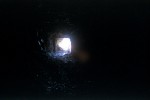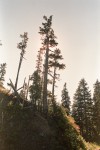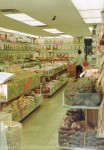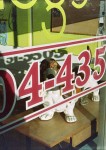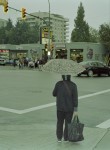Jan
28
2015

This is the second part of the image gallery from my Braun Super Paxette. The first part can be seen here August 2014 Braun Super Paxette
In the interm I’ve picked up another Super Paxette because I like this one so much. The shutter may need a little cleaning but having a backup to this camera is worth it.
1 comment | tags: braun, film camera, Paxette | posted in Cameras, Photography
Jan
24
2015

One of the problems with using old cameras for the first time is that you never know if they are fully functional until later when you get the negatives back. Such is the case with my Yashica Minister D. I knew that there was something up with the focus because the rangefinder did not match the lens distance markings. I decided the safe bet was to use the markings on the lens and not the rangefinder which seemed so out of whack with what I knew the distances to be. Well it turns out that the lens markings were equally wrong or the lens itself has been damaged in some way I will need to have a closer look. In this shot I’m pretty sure that I had focused near infinity and had used a small aparature which should have resulted in everything in the scene being in focus so it seems likely that it is the lens itself. It shall go into ‘the pile’

Some more images that didn’t turn out
3 comments
Jan
21
2015

Lets be honest the only appealing thing about this camera is the fact that it has a 26mm lens which sets it apart from almost all the other point and shoot cameras in the world (including ones in the landfill).
One of the side effects of Canon’s attempt to produce this wideangle wonder was that the corners of the image are so soft that you could stuff a pillow with them.

But is it bad enough to make it good? Not really, 26mm doesnt provide a distinct advantage over the more available 28mm camera’s that I’ve seen and the results are questionable but not bad enough to make it obvious that you ment to do it. The flash doesn’t cover the frame very well and without it it heavily under exposes in darker situations. The focus is fixed as is the aperture at f6. The viewfinder is nice and big though I will give it that.

What I’ve rambled on about this camera before previously Canon BF-10
no comments | tags: camera, Canon, film, wide angle | posted in Cameras, Photography
Jan
18
2015

It’s been one year that I’ve had the HD PENTAX-DA 55-300mm F4-5.8 ED WR and I am still very pleased with it. For the money it is a very good lens and the weather sealing has been a definite plus for me.
It’s minor weak points seem to be an increase in softness and chromatic aberration as you move away from the image center towards the corners and it’s slower aperture at the long end (f5.8) but all things considered it does the job and provides photographic freedom for creating images. The distortions seen in the corners are at their strongest at 300mm and require stopping down to about f8.0 to make an appreciable difference. So after a year of use I would say unless I need f2.8 or some improvement in image quality I tend to take the lighter DA55-300 with me over the DA*50-135 because of its greater versatility and lighter weight. You can see my user review for it here HD PENTAX-DA 55-300mm F4-5.8 ED WR user review and some other thoughts here HD PENTAX-DA 55-300mm F4-5.8 ED WR and the rest of the kids. If I needed to I would buy it all over again.
Bellow are 100% views of some test images I shot. I created and printed a chart specifically to test the performance of the lens.

While I didn’t set the test up with extreme rigor it demonstrates my points and matches my findings in real world situations. The first image bellow is from the center of the HD DA55-300 ED WR at 120mm. You can see that when used at its widest aperture for this focal length the image is somewhat soft and with chromatic aberration showing up as purple fringing. Stopping the lens down to f9.0 decreases this type of aberation leaving primarily transverse aberations as seen by the red fringe on the now sharper image.

It should be noted that with some minor processing the chromatic aberations can be greatly reduced and further adjustments can yeild a superior image as seen in this before and after. Again taken from the center of the frame, now at 300mm but still with a wide open aperture of f5.8

As I mentioned previously the image corners suffer the most when it comes to distortions. The image that follows is taken from the upper left corner with an aperture change from f5.8 to f10 and no further processing.

Here for comparison purposes is a central crop from the DA*50-135 and the DA55-300 both at f9.0 (The camera was moved to provide similar framing) You can see that the DA* 50-135 is sharper and less distorted.

But with a little processing on images from both lenses the playing field is leveled slightly between them.

The image above is from the center of the frame where the image bellow is from the lower left which in the case of my lens seems to be the worst of the corners.

All this should be taken with a little bit of a grain of salt however as these are 100% crops from the demanding 24mpixel Pentax K-3 under more extreme conditions than the average picture is taken.

(The salt picture is taken with the DFA100 WR macro as the HD Pentax-DA 55-300mm F4-5.8 ED WR does not lend itself to this type of image making because of its maximum magnification of 0.28X)
It’s certainly not my intent to leave the reader with a lingering sense that the lens is weak. It’s actually a good lens optically and you are going to have to pay for any improvements either in limiting yourself to fixed focal lengths or by paying more money or both.
Here are some more images from the past year taken with this lens and the Pentax K-3 with a few cameos from the K-01 mirrorless.
2 comments | tags: DA 55-300, DA55-300, HD Pentax, HD Pentax-DA, lens, Pentax, Water resistant, WR | posted in Cameras, Photography
Jan
15
2015

In my previous effort to scan APS film using my DSLR I broke the film container and removed the film, which it turns out is entirely unnecessary. You can easily open an exposed roll of APS film by turning the small shaft near the opening and then turn the central shaft until the film leader comes out.


The Lens on the Elph Jr. is a 26mm f2.8 with 4 elements in 4 groups. That 26mm on APS equates to 32.5mm on 35mm film which sits nicely between my two favourite focal lengths 28mm and 35mm (Yes I know 31.5 is actually the mean number between 28-35 don’t get all statistical on me). The shutter goes from 2sec to 1/800 sec a versatile range of speeds although I don’t know what other apertures are available in cobination with them beyond the wide open f2.8.
Well now that it is sorted and the film is scanned lets see what this little thing can do. The blue rectangles are an artifact of the conversion process I did when converting them from negative to positive.
More about the Elph Jr.
4 comments | posted in Cameras, Photography
Jan
12
2015

Some people might say I have a lot of cameras. But what is a lot anyway? If there are 200 fish in a lake no one would say that’s a lot of fish. So like 200 fish in a barrel my cameras just happen to be close together. Having so much choice does pose some problems though. It’s mostly a tug of war between the competing interests of creating images and playing with cameras. In the simplest of terms when it comes to film cameras there are three main categories to choose amongst each with different benefits. There are the small and light ‘point and shoots’ that you can stuff in a pocket. There are the rangefiners that give better results and are quick and quiet. Then there are the SLR’s like this MZ-6 that are the most versatile but are more of a commitment to carry. If you think choosing which one to take to any given place is easy you should see me trying to leave the house. I know it’s one of those problems that your not allowed to complain about because its not really a problem in the grand scheme of things. The best schenario is when I get to take one of each and a digital camera and an instant camera…oh maybe I can fit a TLR in the bag if I just put that one in a pocket….
no comments | posted in Cameras, Photography
Jan
10
2015
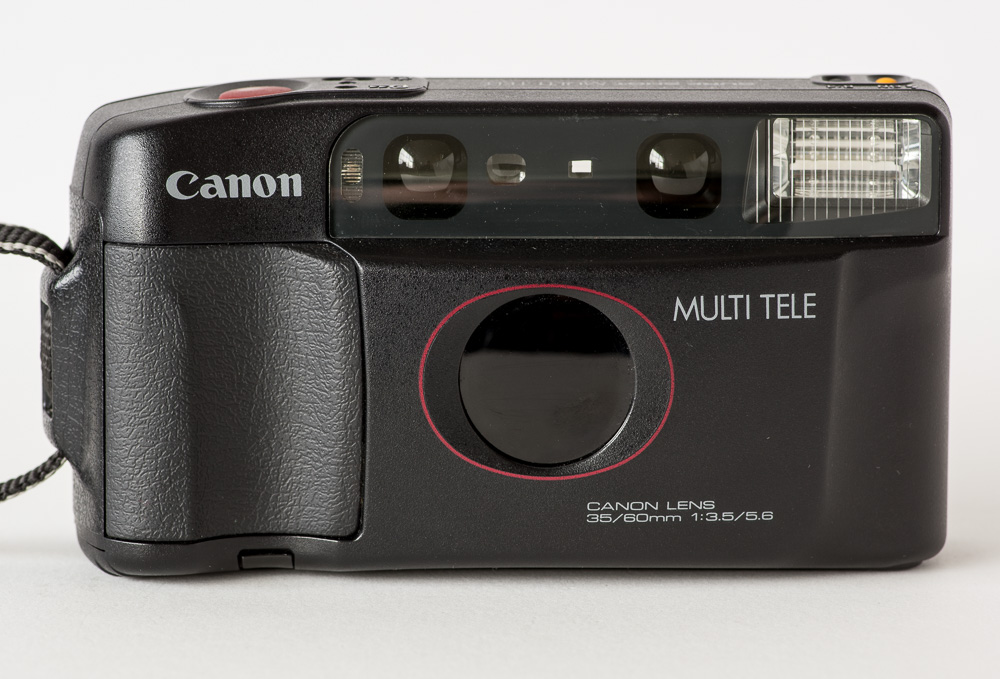
The Canon Multi Tele from 1988 is made of plastic but has a feel and look that is much better than most other cameras from the late 1980’s in fact it doesn’t seem at all out-of-place today, besides the fact that it uses film. It is a particularly interesting camera because of its half frame setting. A choice you have to make before loading the film. The little yellow lever for this is located inside the back. Once set the frame counter on the film back does let you know as well as the viewfinder framing changes to half frame.

When set to half frame the dual focal length lens gives the field of view of 50mm and 85mm when compared to the full frame 35/60mm. Now a 24 exposure roll yields 48 images. Additionally the framing is a vertical portrait orientation, of course you can still turn the camera sideways for a landscape framing.
The focal length choice is set on the back in combination with the on off switch, however the lens remains behind the sliding shield until you fully press the shutter.

On the top of the camera are two buttons one cryptically marked B-4, this is actually a bulb setting of up to 4 seconds. One press of this turns on bulb mode for the next shutter press but considering how much pressure the shutter button requires a very sturdy tripod would be required. The yellow button forces the flash to fire but there is no way to suppress the flash if the camera decides its needed.

There is a teleconverter that goes with this camera but I find it hardly worth mentioning as it is a paltry 1.25X and only available for the tele setting so 60mm goes to 75mm not worth the extra effort and bulk in my opinion.

One thing about one camera: The Multi Tele has a safety Macro mode. If you ignore the warning and attempt to take a picture of something closer than the minimum 2.1foot focal distance the camera will set: the focus to 18″, the focal length to 35mm, an aperture of f16 and fire the flash. I have to try that and see how well it works.
no comments | posted in Cameras, Photography
Jan
6
2015

It has been awhile since I pulled out the Canon WP-1. It’s not the first camera I think of when it comes to fitting in but that’s not true if your going to the beach there it is right at home. It’s toy like appearance hides the fact that it has a fantastic 32mm f3.5 lens. 32mm as I’ve said before sits nicely between 28 and 35mm really giving the best of both worlds just like the Pentax UC1. The big controls designed to be used with gloves or underwater are great and the viewfinder is big and because it is designed to be used with a snorkel mask allows you to hold it away from your eye when composing which is a nice change from the jam it against your face and try to find the light through the tunnel view of many cameras.
I’ve written previously about the camera and those posts can be seen here Canon Wp-1 search
1 comment | tags: camera, Canon, film | posted in Cameras, Photography
Jan
4
2015

Somehow I got out of sequence and #13 was posted before this one but here it is now. I’m having them printed on photographic paper that has a metallic sheen to it with the intention of bringing them together into a single book.
no comments | posted in Painting
Jan
2
2015

Sure there may be prettier cameras and ones with more personality but this Beauty has it all in one package. This camera incorporates all the design and technology that the late 1950’s had to throw at a camera. The 45mm lens has 6 elements in 4 groups with a fast maximum aperture of f1.9. The selenium meter provides a needle displayed on the top plate (I have to admit to not using it though). To trip the shutter the film advance lever needs to be left out slightly providing a shutter lock so it won’t go off in your camera bag.
The rangefinder patch is unusual in that it is a circle where most I’ve come across are squares rectangles or diamond shapes.
More on the Beauty Lightomatic here When Beauty isn’t subjective
no comments | tags: 35mm, film, Lightomatic | posted in Cameras, Photography





















































































































































